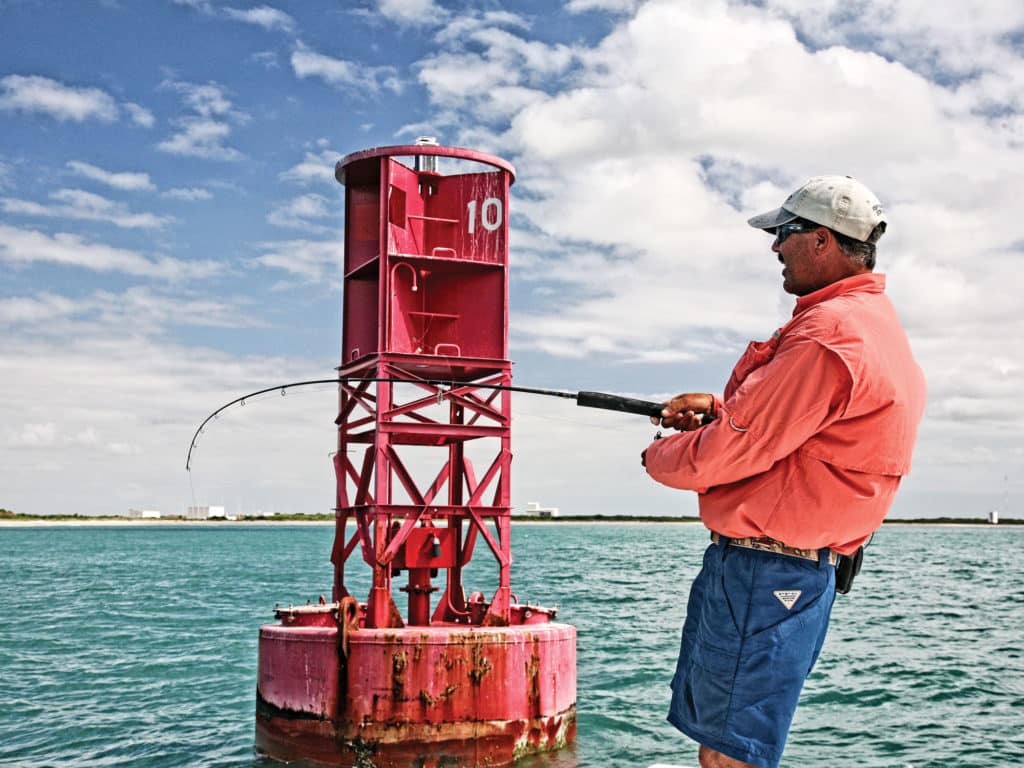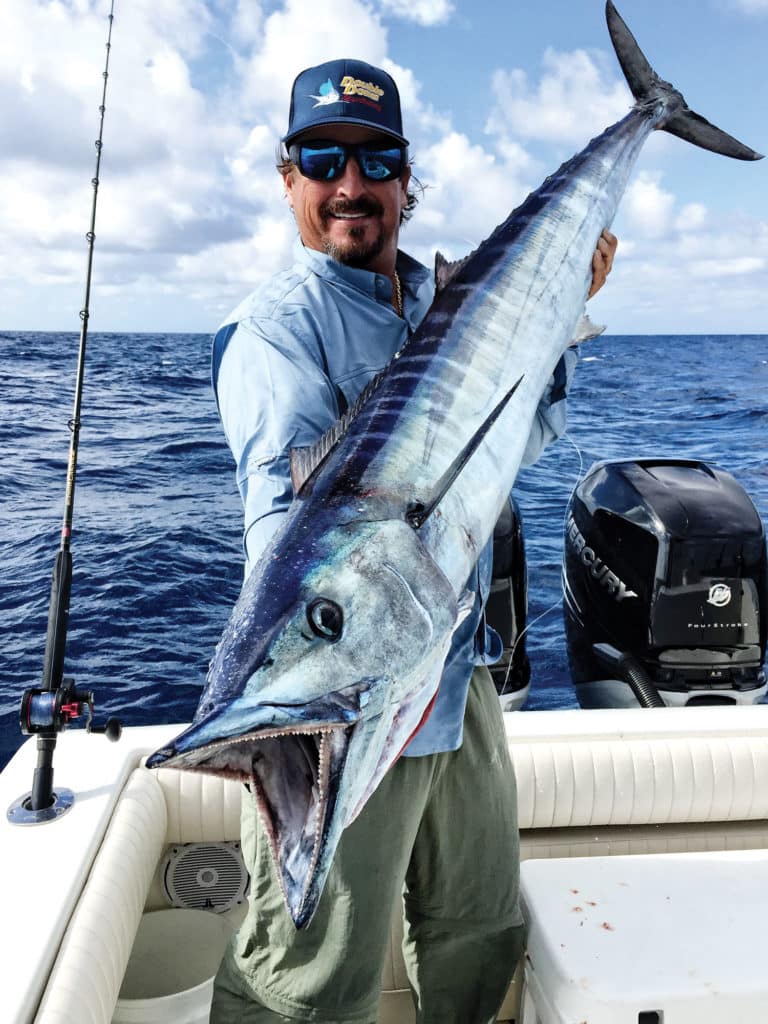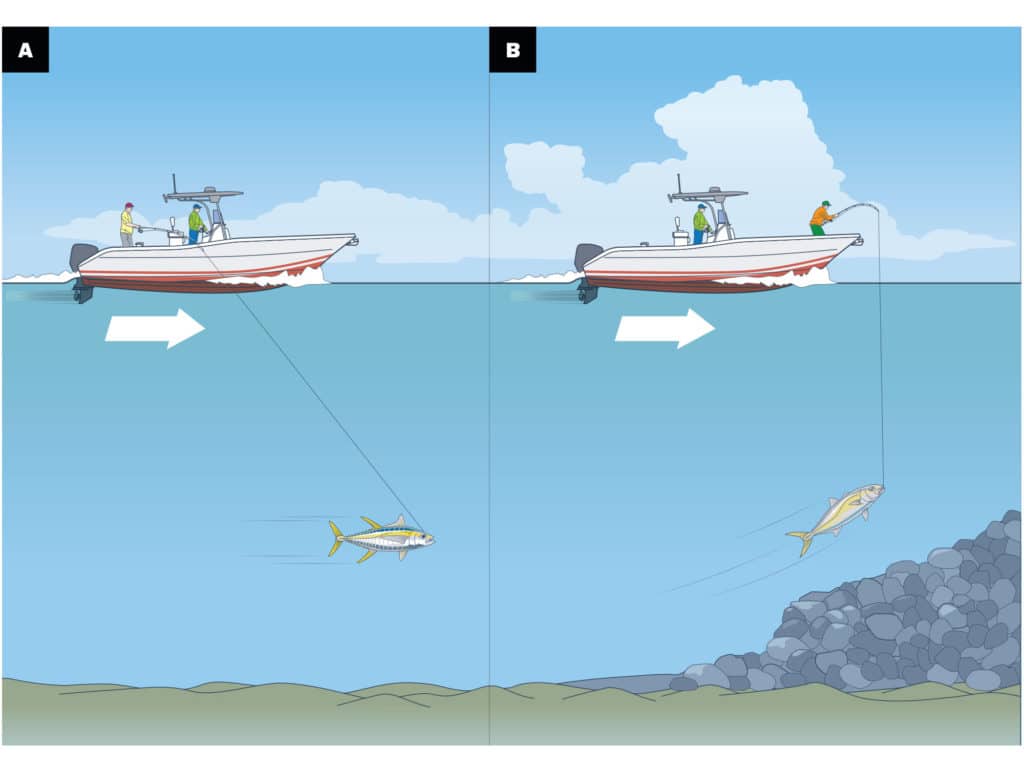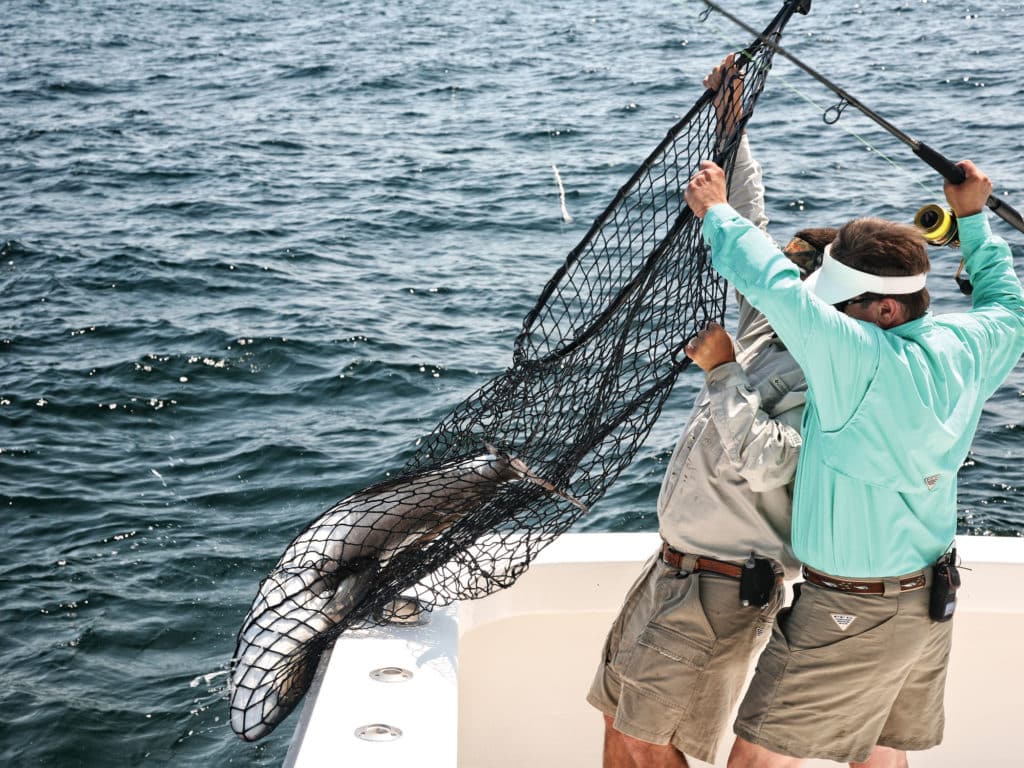
Be it a 50-pound striped bass on 20-pound gear, a 100-plus-pound tarpon on 12-pound, or a sailfish on 8-pound, catching a trophy fish on light tackle is an angler’s true badge of honor.
Success with powerful fish three, four or more times the weight class of the tackle employed demands top-tier equipment, along with forethought, mental discipline and, of course, angling skill. While luck does play a role, the following five tips are crucial for beating oversize fish on light gear. Master them and you’ll notice Lady Luck smiling upon you considerably more often.
Hook-sets
Using brawn to set the hook with 20-pound-class or lighter tackle is counterproductive. Since light lines part easily from sudden shock, rather than rearing back on a large, surging fish, let the fish hook itself. When coming tight, maintain the rod position and simply wind in line until the fish starts running and taking line. If a hook-set warrants additional pressure, cup the reel spool for a split second — just prior to the fish charging off. This is a timing deal, honed only through experience. With a hook appropriately sized (especially with circle hooks), such hook-sets prove smooth, uniform and solid.

Light-Tackle Building Blocks
To make the most of these advanced techniques, every angler must first follow these basics:
1. Match Hardware: Light-tackle fishing calls for fine-tuning at its finest. Don’t select hooks or lures too beefy for the chosen tackle system. Leaders and hooks must complement the strength of your fishing line. Always opt for smaller, light wire hooks and leaders just strong enough to weather an extended battle with the game fish you’re pursuing.
2. Fresh Line: Replace light fishing line after each encounter with a large fish. Though the line may still appear to be in good shape, its properties have likely been compromised. The line is bound to be weaker, and its breaking strength more inconsistent. Carry two or more identically rigged outfits or, at the very least, backup reel spools with fresh line.
3. Avoid Heat: Heat is a mortal enemy of monofilament and fluorocarbon, so keep such lines, particularly the lighter weight classes, out of hot, poorly ventilated areas such as covered pickup truck beds, parked cars with shut windows, and garage shelves near windows. Aboard a boat, outfits not in use should be stowed out of the sun, or sport reel covers or a towel to shield the lines. In the back of a truck, layer them between blankets to avoid any damage from direct heat.
Get High
When fishing over reefs, near wrecks, and around abrupt drop-offs the likes of channels and offshore ledges, many fish end the fight by dragging the line across obstructions, severing their connection with the angler. But switching to a more elevated position and raising the rod tip will make the angle of the line more vertical, helping to prevent that from happening.
Anchored in 70 feet of water off Bimini recently, I was trying to capitalize on the large cero mackerel in our chum slick when a huge kingfish charged in and consumed my bait. After setting the hook, I immediately stood on a cooler and held the rod and reel fairly high to maintain a more vertical line entry into the water; I was hoping the angle would prove aggressive enough to keep my line from contacting obstructions along the fish’s path. Line raced off the spool, but with our camera boat anchored next to us, we opted not to break free from the anchor line and give chase. We had boated big kings while at anchor before, so we attempted it again. And some 40 minutes and a lot of finessing later, we sank the gaff into the 55-pounder, the largest king I’ve taken from an anchored boat to date — and on a light yellowtail outfit.

Give Chase
The goal around threatening bottom structures and prominent ledges is to stay above the fish to keep the line nearly vertical. Under normal fishing conditions (when not shooting a TV show), we would have given chase; we would uncleat and toss overboard the anchor line, with the end tied to a poly ball. Said float should be secured to the end of the anchor line before the first bait is set so you’re able to quickly and easily reclaim your position in the chum slick after you follow a hooked fish. When chasing fish in deep, open water, maintain about three-quarters of the spool’s line capacity. Keeping the fish fairly close enhances your ability to steer the line around weed clumps and other flotsam, decreasing the possibility of nicks. It also minimizes the pressure that builds on the line as the length dragged through the water by a hooked fish increases. The goal is to let the fish run and wear itself down while keeping a short, taut leash. As the fish tires, you slowly but surely close in on it.
Loosen Drag
A rapidly diminishing spool diameter increases drag pressure, as does excess line dragging through the water. Because my reel’s spool diameter was nearing half empty during the initial run of that huge king, I backed off the drag a good bit to alleviate the building pressure. Had I not, the end result would have been a straightened or pulled hook, or a broken leader or main line.
I recall catching sailfish on 8-pound tackle, where the strike drag was dialed in at 2 pounds. As we gave chase during the sails’ long runs, I backed off the drag even more: The tension from the line being pulled through the water proved sufficient to keep the hook in the fish. After we had our fun, we’d race up to the leader, bill the fish, remove the hook, and turn them free. Because we gave chase at every opportunity, all the fish were still strong when we released them.

Mental Discipline
Next to not backing off a drag on a long-running fish, or, worse, increasing the drag in an attempt to slow or stop it, lack of mental discipline accounts for many light-tackle losses. Unlike heavy gear, which is very forgiving, there’s no room for errors when fighting big fish on light tackle. Eliminating additional drag (cupping the spool or fingering the line) prior to a fish running, failing to extend the outfit toward a fish just enough to neutralize sudden drag surges as it takes to the air or blazes off on a run, and losing your cool during a tedious standoff and putting excessive pressure on a fish are all prime examples.
The mere sight of a big fish immediately works on the angler’s mind: We all want that trophy in the boat now. As a fight plays on, and especially when a fish is dominating, frustration sets in. Despite how challenging and drawn out a fight, remain positive. Always remember, the goal with light tackle (unless you’re into trick catches such as hooking a fish, then immediately racing for the leader and scoring a “release” without the fish even realizing it’s hooked) is to let the fish wear itself down. Enjoy the long runs, keep tight to the fish, and gain line when you can.
Eventually, as long runs diminish into stubborn give-and-take skirmishes, a rhythm will be established based on the fish’s antics and what is working to reclaim line. Stay focused on that rhythm. Stray from it and the hooked fish will most likely respond by suddenly changing pace, making a desperate run when you least expect it. As a big fish nears the boat, especially when it comes into view, an adrenalin rush will spike the desire to end the fight. But at this stage, it’s imperative to not apply excessive pressure or change the rhythm. Relax, continue to play the fish, and let the designated gaff or net man do his job. Calmness does indeed prevail.









